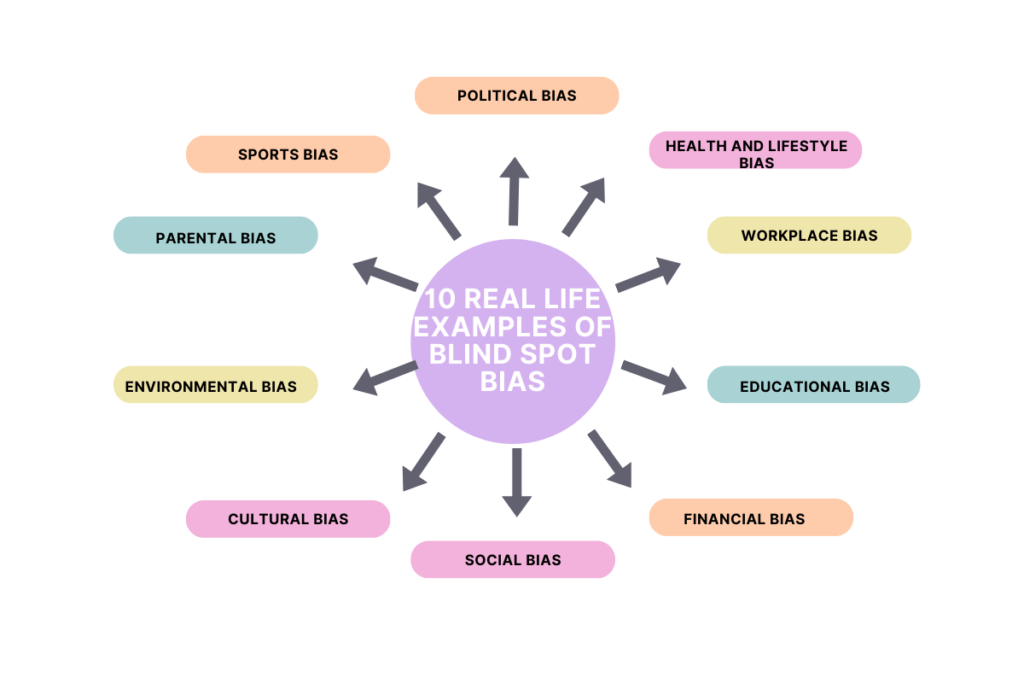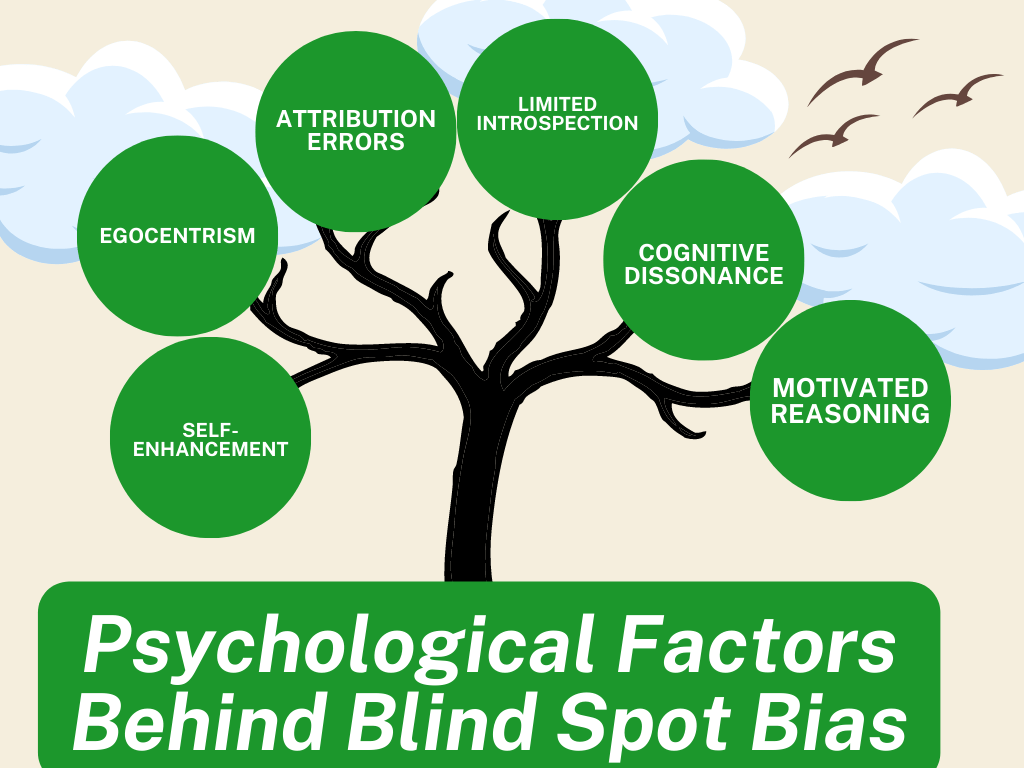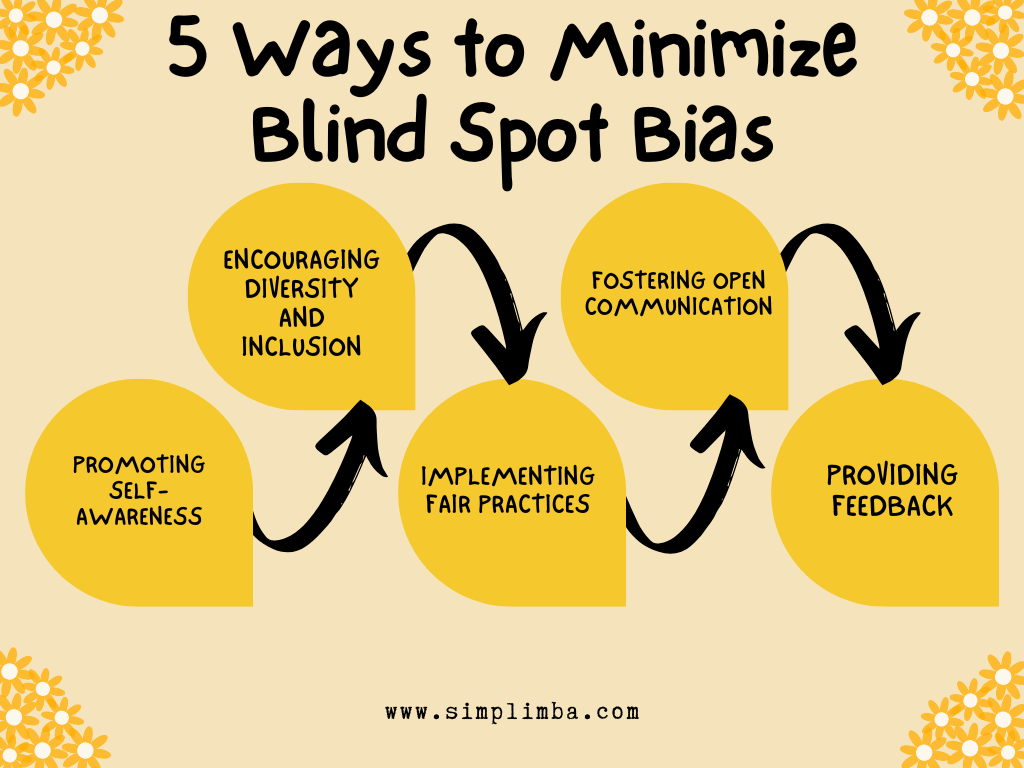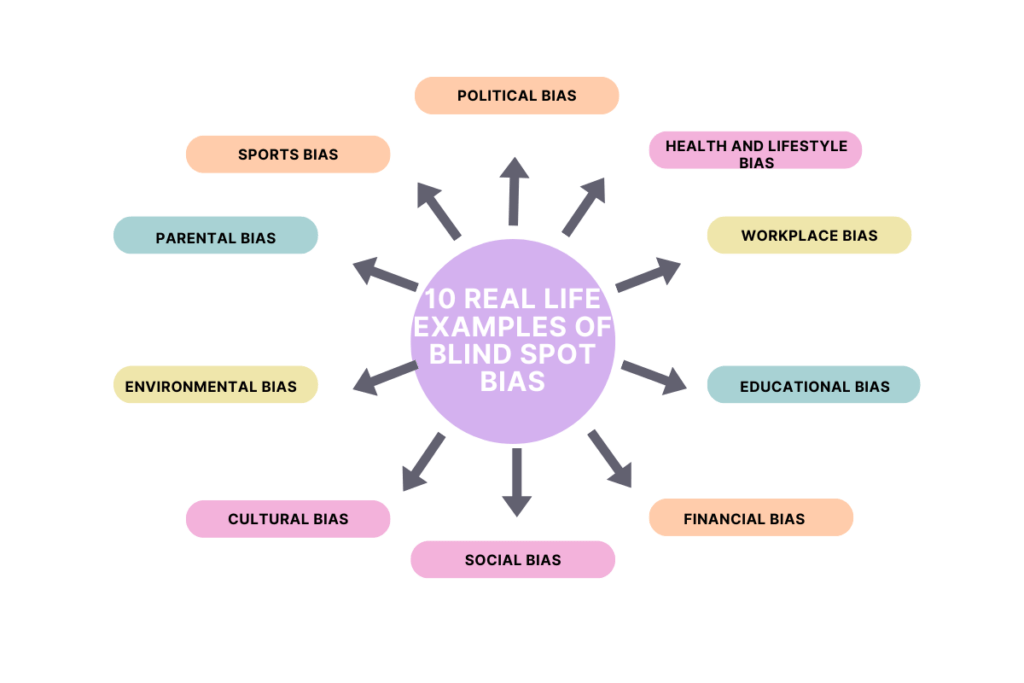Blind Spot Bias, also known as the Blind Spot Bias, is a cognitive bias that leads individuals to perceive themselves as less biased than others. It’s a fascinating psychological phenomenon that affects our judgment, decision-making, and interactions in subtle yet significant ways.
The term “blind spot” (Blind Spot Bias) is a fitting metaphor, borrowed from the field of vision science. Just as our eyes have a physical blind spot where we can’t see, our minds too have a metaphorical blind spot where we fail to recognize our own biases. This lack of self-awareness can lead to flawed reasoning and skewed perspectives.
The Blind Spot Bias is a universal human trait, affecting people regardless of intelligence, profession, or level of education. It’s a bias about bias, a meta-bias, if you will. We are often quick to spot biases in others but fail to see our own. This can lead to a false sense of objectivity and righteousness, as we believe our views to be unbiased and accurate, while others’ views are distorted by bias.
Understanding and acknowledging the Blind Spot Bias is the first step towards mitigating its effects. By becoming aware of this bias, we can strive to be more objective in our judgments, more open to differing viewpoints, and more reflective about our own thought processes.
In the following sections, we will delve deeper into the concept of Blind Spot Bias, exploring its causes, implications, and strategies for overcoming it. We will also look at real-life examples to illustrate how this bias manifests in various domains, from business and banking to education and leadership.
10 Real Life Examples of Blind Spot Bias

Political Bias: A person might believe that their political views are based purely on facts and logic, while others’ views are influenced by their biases. They fail to see that their own political beliefs can also be biased by their upbringing, social circle, or media consumption.
Health and Lifestyle Bias: Someone might criticize others for unhealthy lifestyle choices like smoking or not exercising, while overlooking their own unhealthy habits such as excessive consumption of junk food or lack of sleep.
Workplace Bias: A manager might think that they are completely objective in their performance evaluations, while accusing other managers of favoritism or bias. They might not realize that they too could be unconsciously favoring certain employees due to similarities in background, personality, or interests.
Educational Bias: A teacher might believe that they grade students purely based on performance, while accusing other teachers of being biased. They might not notice their own bias in favoring students who are more engaged or well-behaved.
Financial Bias: An investor might accuse others of making investment decisions based on emotions or biases, while believing that their own decisions are purely data-driven. They might overlook their own biases such as overconfidence or aversion to loss.
Social Bias: A person might criticize their friends for being influenced by popular opinion, while believing that they themselves are immune to such social pressures. They might not realize that their own opinions could also be swayed by social trends or peer influence.
Cultural Bias: A person might accuse others of being biased by their cultural norms or traditions, while believing that their own views are universally valid. They might not see how their own cultural background shapes their perspectives.
Environmental Bias: An environmentalist might accuse others of not caring enough about the environment, while overlooking their own environmentally unfriendly habits like excessive use of plastic or energy.
Parental Bias: Parents might believe that they treat all their children equally, while accusing other parents of favoritism. They might not notice their own bias in favoring a child who is more similar to them in personality or interests.
Sports Bias: A sports fan might accuse other fans of being biased towards their favorite teams, while believing that their own support is based purely on the teams’ performance. They might not realize their own bias in favoring their home team or the team they have been supporting since childhood.
Psychological Factors Behind Blind Spot Bias

Self-Enhancement: Humans have a natural tendency to view themselves in a positive light. This self-enhancement bias leads us to believe that we are better than average in many aspects, including our ability to make unbiased judgments. We tend to downplay our own biases while emphasizing those of others.
Egocentrism: This is the tendency to focus on our own perspective and experiences, often at the expense of others’ perspectives. Egocentrism can make it difficult for us to recognize our own biases, as we inherently believe our viewpoint to be the most accurate and objective.
Attribution Errors: We often attribute our own actions and beliefs to rational, objective factors, while attributing others’ actions and beliefs to their personal biases or character flaws. This is known as the Fundamental Attribution Error, and it can contribute to the Blind Spot Bias.
Limited Introspection: While we can introspect and analyze our conscious thoughts and decisions, many of our biases operate at a subconscious level. This makes it difficult for us to recognize and acknowledge our own biases.
Cognitive Dissonance: Recognizing our own biases can create cognitive dissonance, a state of mental discomfort that arises from holding contradictory beliefs or values. To avoid this discomfort, we might deny or overlook our own biases.
Motivated Reasoning: This is the tendency to process information in a way that confirms our pre-existing beliefs and values. Motivated reasoning can lead us to selectively ignore or dismiss evidence of our own biases.
Blind Spot Bias Defintion
“Bias Blind Spot: Structure, Measurement, and Consequences” by Scopelliti, Irene, Morewedge, Carey K., McCormick, Erin, Min, H. Lauren, Lebrecht, Sophie, and Kassam, Karim S. (2015): This study provides a comprehensive analysis of the bias blind spot. It explores its structure, measurement, and consequences, and finds that individuals who are more cognitively sophisticated have a larger bias blind spot.
“The Bias Blind Spot: Perceptions of Bias in Self Versus Others” by Pronin, Emily, Lin, Daniel Y., and Ross, Lee (2002): This paper presents a series of studies that demonstrate people’s blindness to their own biases. It suggests that this bias blind spot arises from a tendency to rely on introspection to perceive biases in oneself, while relying on more observable information to perceive biases in others.
“The Bias Blind Spot and Its Implications” by West, Richard F., Meserve, Russell J., and Stanovich, Keith E. (2012): This study explores the implications of the bias blind spot for various domains, including education, business, and healthcare. It suggests that interventions aimed at reducing the bias blind spot could have wide-ranging benefits.
“The Bias Blind Spot: Structure, Measurement, and Consequences” by Scopelliti, Irene, Morewedge, Carey K., McCormick, Erin, Min, H. Lauren, Lebrecht, Sophie, and Kassam, Karim S. (2015): This research provides a comprehensive analysis of the bias blind spot. It explores its structure, measurement, and consequences, and finds that individuals who are more cognitively sophisticated have a larger bias blind spot.
Bias Blind Spot in Banking
In the banking sector, the bias blind spot can have significant implications. For instance, loan officers might believe that their decisions are purely based on objective criteria such as credit scores and income levels, while accusing others of being influenced by personal biases or stereotypes. They might overlook their own biases, such as favoring clients who are similar to them in terms of background or personality, or being more lenient with clients who are persuasive or likable. This can lead to unfair lending practices and financial risks. To mitigate this bias, banks can implement standardized procedures for evaluating loan applications and provide bias training for their staff.
Bias Blind Spot in Business
In business, the bias blind spot can affect various aspects such as hiring, performance evaluations, decision-making, and negotiations. Managers might believe that they are completely objective, while accusing others of favoritism or bias. They might not realize that they too could be unconsciously favoring certain employees or ideas due to similarities in background, personality, or interests. This can lead to a lack of diversity and innovation, and hinder the company’s growth and success. Businesses can address this bias by promoting diversity and inclusion, implementing objective evaluation criteria, and encouraging open and constructive feedback.
Bias Blind Spot in Education
In the field of education, teachers might believe that they grade students purely based on performance, while accusing other teachers of being biased. They might not notice their own bias in favoring students who are more engaged or well-behaved, or students who share similar interests or backgrounds. This can lead to unfair grading practices and hinder students’ learning and development. To overcome this bias, educators can strive to be aware of their potential biases, use objective grading rubrics, and seek feedback from colleagues and students.
Bias Blind Spot in Leadership
In leadership, the bias blind spot can lead to flawed decision-making and interpersonal conflicts. Leaders might think that their decisions are unbiased and rational, while accusing others of being influenced by personal biases or emotions. They might not see their own biases, such as preferring information that confirms their pre-existing beliefs, or favoring team members who agree with them. This can result in poor decisions, low team morale, and a lack of trust and collaboration. Leaders can mitigate this bias by seeking diverse perspectives, encouraging dissenting opinions, and reflecting on their own decision-making processes.
5 Ways to Minimize Blind Spot Bias
Blind Spot Bias can significantly impact the health and productivity of a workplace. It can lead to unfair practices, miscommunication, and conflicts, which can negatively affect employee morale, job satisfaction, and overall performance. However, by recognizing and addressing this bias, organizations can foster a more inclusive, fair, and healthy workplace. Here’s how:

Promoting Self-Awareness: The first step in addressing Blind Spot Bias is to promote self-awareness among employees. This can be achieved through training programs that educate employees about different types of biases, including the Blind Spot Bias. These programs can help employees recognize their own biases and understand how these biases can affect their judgments and decisions.
Encouraging Diversity and Inclusion: A diverse and inclusive workplace can help mitigate the effects of Blind Spot Bias. When employees are exposed to diverse perspectives and experiences, they are more likely to recognize their own biases and strive to be more objective. Inclusion initiatives can also ensure that all employees feel valued and respected, which can reduce the likelihood of bias-related conflicts.
Implementing Fair Practices: Organizations can implement practices that minimize the impact of biases. For instance, in hiring and promotions, they can use standardized evaluation criteria and anonymized applications. In performance evaluations, they can use objective metrics and multiple raters. These practices can help ensure fairness and objectivity.
Fostering Open Communication: Encouraging open communication can help address Blind Spot Bias. Employees should feel comfortable discussing biases and their impacts. This can lead to greater understanding and empathy, and help prevent miscommunication and conflicts.
Providing Feedback: Regular feedback can help employees recognize their biases and improve their judgments and decisions. Feedback should be constructive, specific, and focused on behaviors rather than personal traits.
Samrat is a Delhi-based MBA from the Indian Institute of Management. He is a Strategy, AI, and Marketing Enthusiast and passionately writes about core and emerging topics in Management studies. Reach out to his LinkedIn for a discussion or follow his Quora Page

